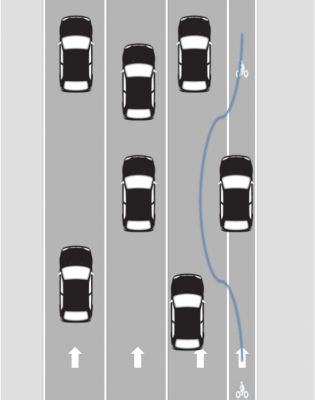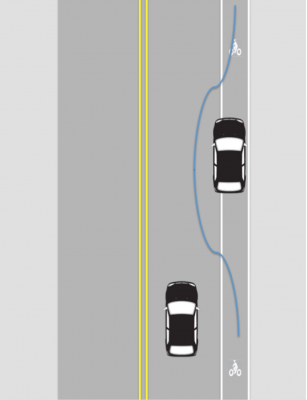The MBTA needs to raise revenue. They have a proposal here: http://www.mbta.com/about_the_mbta/?id=23567
and are soliciting feedback.
I just sent them my thoughts via email. Anyone care to comment?
———————————
Greetings,
For MBTA services that provide both transportation and parking (e.g., commuter rail, subway stations like Braintree, Alewife, etc.), there are two ways to increase user fee based revenue so that riders contribute to revenue. Below I make the case that it is more socially equitable to increase revenue by charging more for parking than it is by charging more for riding the train.
————–
Discussion:
User fees can be raised in one or both of the following ways:
1. Increase the fee for providing transportation. This is the rider fare. An increase in rider fare means **every** rider pays more for transportation services.
2. Increase the price to park at MBTA stations. An increase in this price still raises revenue from riders, but only where people “park and ride”, so again it only applies at commuter rail stations and subway stations where people tend to drive to the station.
Let’s look at the impact of raising revenue via each of these mechanisms. For simplicity, let’s use the following assumptions:
* Calculations are computed over a monthly basis. Assume an average of 20 “work days” per month.
* Assume a revenue increase of $10 per month per rider.
Discussion:
Consider two hypothetical people: Danny Driver and William Walker. Both commute to Boston from a Zone 3 commuter rail station for “nine to five weekday” jobs. Danny Driver takes his car to the commuter lot then rides the train to and from work, while William Walker walks 2 miles from home to the station and back.
Mr. Driver’s monthly cost is currently $212 (price of a Zone 3 monthly train pass), plus $80 to $140 for parking (cite: MBTA daily parking rate is $4 to $7 per day, http://www.mbta.com/riding_the_t/parking/?transittype=Subway&rn=Blue). Oh, and Danny Driver seems content to pay at least $7000 a year for a car (cite: http://newsroom.aaa.com/2013/04/cost-of-owning-and-operating-vehicle-in-u-s-increases-nearly-two-percent-according-to-aaas-2013-your-driving-costs-study/) that he leaves in a parking lot all day.
Mr. Walker, who for whatever reason is stretched thin financially, can’t afford to pay for a car that sits in a parking lot all day. He walks between home and the MBTA station. His monthly transportation cost is $212 per month, plus the cost of a new pair of shoes once in a while.
Let’s look at how different ways to raise revenue impact these two people. The current MassDOT/MBTA plan is to increase the cost of a Zone 3 monthly pass by $10. What if instead, MBTA raised the parking rate by $0.50 per day (which, at an assumed 20 workdays a month, would be a $10 per month increase)? For Mr. Driver, there is no difference whatsoever. His cost increases by $10 whether that comes from a monthly pass increase or from a parking fee increase. If Mr. Driver might balk at this transportation cost increase and “vote with his wheels”. He might not realize how costly driving truly is (it’s about $0.60 per mile, cite: https://exchange.aaa.com/wp-content/uploads/2013/04/Your-Driving-Costs-2013.pdf), turn his back on the commuter rail lifestyle, and start driving to work. Why not, he already has so much invested in owning a car…
In contrast, the approach you take for raising revenue makes a big difference to Mr. Walker. Mr. Walker doesn’t own a car, so does not pay to park. If revenue is generated through a parking rate increase, people like Mr. Walker get a break. And, going back to the original hypothetical – Mr. Walker is economically disadvantaged. In his budget, every penny counts. Moreover, Mr. Walker doesn’t have a car, so he can’t take to driving as a protest to the MBTA revenue increase. He has no choice but to sit there and take it.
————–
Loophole:
There’s a third type of person I’ve so far left out. Let’s call him Stanley Schemer. Mr. Schemer enjoys finding and exploiting loopholes. He’s the type of guy who will drive an extra 10 miles to avoid a $1 toll. Mr. Schemer presently drives to the same station as Mr. Walker and Mr. Driver. Suppose MBTA/MassDOT decide to increase the parking rate instead of the train fare. Mr. Schemer notices that he can avoid the $10 cost bump by riding his bike 6 miles to the train station instead of driving. In this case, the MBTA continues to carry a passenger (Mr. Schemer) without a raise in fare box revenue while at the same time losing parking revenue (assuming someone else does not fill in that parking spot). Sounds like a bad deal at first, but is it? I say no. First, Mr. Schemer is getting to work without adding his car to the congested highways. At the same time he is not creating traffic, and extracting wear & tear on local roads, to get to the train station. Finally, by shifting from car to bike for a substantial part of his commute, Mr. Schemer is helping MassDOT achieve its mode share shift goal (cite: http://www.massdot.state.ma.us/main/tabid/1085/ctl/detail/mid/2937/itemid/223/MassDOT-Announces-Mode-Shift-Goal-to-Triple-the-Share-of-Travel-in-Massachusetts-by-Bicycling–Transit-and-Walking-.aspx).
————–
Doing the math:
MBTA owns 55,000 parking spots (source: http://www.mbta.com/riding_the_t/parking/?transittype=Subway&rn=Blue)
We should assume these spots are fully utilized during work days – otherwise, MBTA should sell the unutilized land. For simplicity, let’s also assume zero occupancy on holidays and weekends. There are about 20 work days each month month, 12 months a year.
55000spots * 20days/month * 12months/year = 6.6 million spot-days. An increase of $0.50 for parking will raise $3.3 million in revenue.
————–
Finally…
Let’s look beyond the social equity issue for a minute and glance at simple economics. How much does it cost to provide parking, and how much revenue does it generate? Using the same math as above: 20 work days a month times 12 months times the parking rate ($4 to $7), we see max revenue per space of ~$1000-$1600 annually.
By some studies, the annual cost of operating parking is $500 to $800 per space (this cost completely ignores the cost of parking lot or structure construction (thus debt principal and interest payments) and replacement). Net revenue from parking at between $200 and $1100. If parking fees are not increased over time to keep pace with inflation, we’re in danger of netting zero – or negative dollars – from some of these spaces in the not-too distant future.
MBTA and MassDOT need to look closely at the cost of providing parking versus the opportunity and equity of using it as a source of increased revenue to ensure fair box increases don’t disproportionately impact the poor, or worse – become a de facto funding stream to subsidize private motor vehicle storage.



